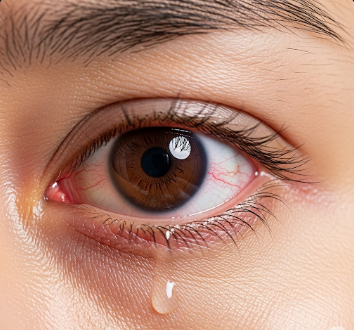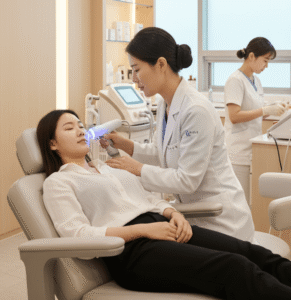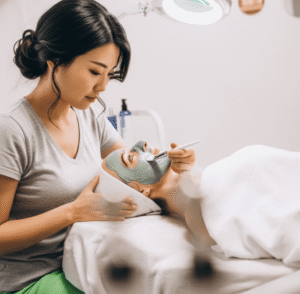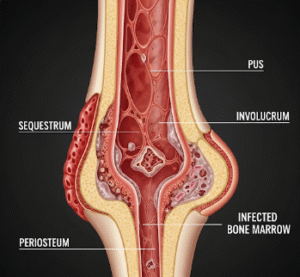Overview
Eye irritation is a common condition characterized by discomfort, redness, itching, or a burning sensation in the eyes. It can result from a variety of causes, including environmental factors, infections, allergies, or underlying ocular diseases. Eye irritation affects daily activities such as reading, driving, or using digital devices, and prolonged irritation may lead to more serious eye problems. In Korea, ophthalmology clinics and eye care centers provide thorough evaluation, diagnosis, and treatment to alleviate symptoms and prevent complications.
Highlights:
➤ Discomfort, redness, and burning sensation – Common signs of eye irritation
➤ Caused by multiple factors – Allergens, infections, environmental irritants, or underlying disease
➤ Can affect daily functioning and quality of life
Key Facts
➤ Prevalence: Eye irritation is very common across all age groups, particularly among those exposed to screens, pollution, or allergens
➤ Age affected: Can affect infants, children, adults, and the elderly
➤ Gender: Both males and females are equally affected
➤ Impact: May cause difficulty reading, blurred vision, fatigue, and reduced productivity
What is Eye Irritation?
Eye irritation refers to a general discomfort in the eyes, which may be acute or chronic, mild or severe. It arises when the eye’s surface or internal structures are affected by external or internal factors. Key characteristics include:
- Redness or bloodshot eyes – Resulting from inflamed blood vessels
- Itching or burning – Common in allergic or dry eye conditions
- Tearing or watery eyes – Reflex response to irritation
- Foreign body sensation – Feeling that something is in the eye
Highlights:
➤ Can range from mild annoyance to severe discomfort
➤ Often resolves with treatment or removal of the irritant
➤ Persistent symptoms require evaluation to prevent complications
What Symptoms Are Related to Eye Irritation?
➤ Redness of the eyes – Due to inflammation or infection
➤ Itching or burning sensation – Common with allergies or dry eyes
➤ Excessive tearing or watery eyes – Protective mechanism
➤ Dryness or gritty feeling – Often caused by dry eye syndrome
➤ Sensitivity to light (photophobia) – Can indicate more serious ocular involvement
➤ Blurry vision – Temporary or persistent, depending on the cause
➤ Foreign body sensation – Feeling like sand or dust is in the eye
Highlights:
➣ Symptoms may vary based on the underlying cause
➣ Persistent or severe irritation warrants professional evaluation
What Causes / Possible Causes
➤ Allergic reactions: Pollen, dust, pet dander, or cosmetics
➤ Infections: Viral or bacterial conjunctivitis, keratitis
➤ Dry eye syndrome: Reduced tear production or poor tear quality
➤ Environmental factors: Smoke, pollution, wind, chlorine in pools
➤ Contact lenses: Poor hygiene or extended wear
➤ Eye strain: Prolonged screen time or poor lighting
➤ Underlying eye diseases: Glaucoma, blepharitis, or uveitis
Highlights:
➣ Causes can be temporary, environmental, or related to chronic conditions
➣ Identifying the trigger is essential for effective management
When Should I See My Doctor?
➤ Persistent eye irritation lasting more than a few days
➤ Severe redness, pain, or photophobia
➤ Sudden vision changes or blurred vision
➤ Discharge or pus from the eye – May indicate bacterial infection
➤ History of eye injury or surgery – To rule out complications
Highlights:
➣ Early consultation with a Korean ophthalmologist prevents worsening of the condition
➣ Timely intervention protects eye health and vision
Care and Treatment
➤ Artificial tears and lubricating drops: To relieve dryness and irritation
➤ Cold or warm compresses: Reduce inflammation and soothe discomfort
➤ Allergen avoidance: Limiting exposure to pollen, dust, or other triggers
➤ Proper eye hygiene: Cleaning eyelids and lashes to prevent infection
➤ Medication: Antibiotic or anti-inflammatory eye drops for infections or inflammation
➤ Behavioral adjustments: Reducing screen time, taking breaks, and improving lighting
Highlights:
➣ Treatment is usually targeted at the underlying cause
➣ Combination of self-care and medical management ensures relief and prevents recurrence
Treatment Options in Korea
Medical Treatments:
➤ Ophthalmology clinics: Comprehensive eye examination to identify cause
➤ Prescription eye drops: Antibiotics, antihistamines, or anti-inflammatories
➤ Artificial tears and lubricants: Customized for dry eye or allergy-related irritation
Advanced Procedures:
➤ Allergy testing and immunotherapy: For severe allergic eye irritation
➤ Meibomian gland therapy: For chronic blepharitis or dry eye
➤ Minor surgical interventions: For persistent foreign body sensation or structural abnormalities
Rehabilitation & Follow-Up Care:
➤ Regular eye check-ups to monitor symptoms and eye health
➤ Education on preventive strategies, proper lens care, and environmental adjustments
➤ Multidisciplinary care for patients with systemic conditions affecting eye health
Highlights:
➣ Korean eye centers provide advanced diagnostics, targeted therapy, and long-term management
➣ Early evaluation ensures symptom relief and protection of vision













